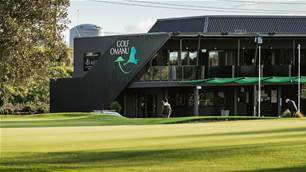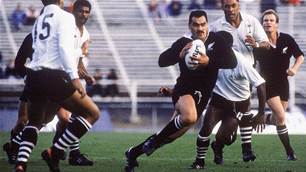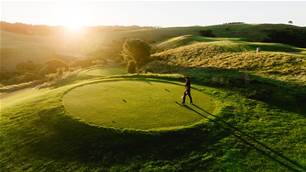If you are after a Sandbelt experience that will have you craving more because you’ve had a lot of fun from holes 1 to 18, Long Island is the course for you.
The 9th is the shortest hole at Long Island but that makes it no less treacherous. The green is huge for such a short hole so, therefore, the penalty for missing such a target is stiff. Three deep bunkers line the putting surface to the left and another two bunkers can be found to the right, while there is a steep drop-off awaiting the player who hits too strong and over the back of the green. This hole also runs across the highest point of the course and on windy days club selection here can be the difference between making par and a double or triple bogey.
The opening hole of the back nine, again well named as ‘Dogleg’, is a Sandbelt classic. From the elevated tee, the hole plays much shorter than its 350 metres if you can tip-toe your drive past the edge of the bunker on the inside corner of the dogleg. Stray into the bunker and the best you will do here is make bogey. Find the fairway and a short iron into a receptive green will give you a shot at birdie.
Actually whoever was responsible for naming the holes at Long Island did a great job. The par-4 11th is another of the appropriately named offerings around this par-72 layout. Known as ‘The Lane’, the 338-metre hole is seemingly tighter than most of the holes requiring a driver from the tee. A massive bunker cutting in from the left indicates the best direction from the tee. Long hitters can fly the edge of the bunkers to leave a wedge into the green, which slopes markedly right to left. Shorter hitters might consider coming into the green from the right half of the fairway to take the left greenside bunker out of play.
Five strong par-4s close out the round with the longest, and perhaps best, of the quintet being the 384-metre 17th, known as ‘The Rise’. Thick clumps of ti-tree, just beyond thin strips of rough, border both sides of the fairway ready to inflict the ultimate penalty on the misguided drive. Ideally, the tee shot should be played to the left half of the fairway to offer the best approach to the elevated green, which slopes markedly from back right to front left. The scheme of bunkers to the right of the green inevitably causes most players to aim for the centre or left half of the green but the steep slope of the putting surface can feed the ball off onto the fringe or into greenside rough.
In an era where there are plenty of new courses being built that are designed to punish and send you home with far less golf balls than when you started, it is great to play a course that is designed to be enjoyable and is fully complemented with beautifully kept playing surfaces. For me, Long Island is one of those courses.
Related Articles

International Spotlight: Omanu Golf Club

Celebrity Kiwi couple tee off in paradise



.jpg&h=115&w=225&c=1&s=1)









